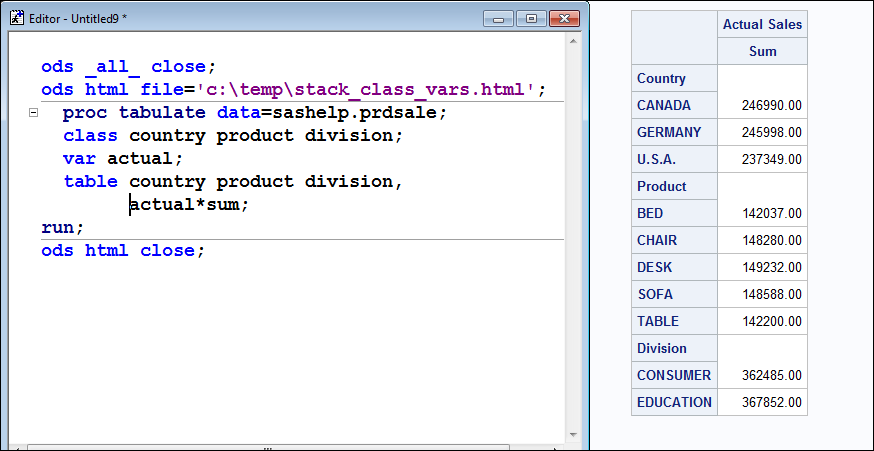- Home
- /
- Programming
- /
- SAS Procedures
- /
- Re: Proc Report help
- RSS Feed
- Mark Topic as New
- Mark Topic as Read
- Float this Topic for Current User
- Bookmark
- Subscribe
- Mute
- Printer Friendly Page
- Mark as New
- Bookmark
- Subscribe
- Mute
- RSS Feed
- Permalink
- Report Inappropriate Content
Can anyone tell me the proc report version of the following code?
proc tabulate data=abc;
class rule1 rule2 rule3;
var profit;
table rule1 rule2 rule3, profit*sum;
run;
Here rule1,rule2 and rule3 are binary variables with values 0,1. profit is continuous variable.
Thanks in advance..
Accepted Solutions
- Mark as New
- Bookmark
- Subscribe
- Mute
- RSS Feed
- Permalink
- Report Inappropriate Content
Hi,
With TABULATE, you are "stacking" the table for RULE1 on top of the table for RULE2 on top of the table for RULE3. This is a unique capability of PROC TABULATE. It really doesn't matter that your "RULE" variables are binary variables or not. For example, look at this output from TABULATE where the variables shown in the row dimension are NOT binary variables. PROC TABULATE is stacking the table for COUNTRY on top of the table for PRODUCT, on top of the table for DIVISION.
There is no direct PROC REPORT ability such as TABULATE has to "stack" items in the row dimension of a table. You would have to restructure your data to even come close to what TABULATE is doing. For example, PROC REPORT would not be able to do this type of report, such as I shown in the screen shot, without restructuring the data in SASHELP.PRDSALE.
cynthia

- Mark as New
- Bookmark
- Subscribe
- Mute
- RSS Feed
- Permalink
- Report Inappropriate Content
Hi,
With TABULATE, you are "stacking" the table for RULE1 on top of the table for RULE2 on top of the table for RULE3. This is a unique capability of PROC TABULATE. It really doesn't matter that your "RULE" variables are binary variables or not. For example, look at this output from TABULATE where the variables shown in the row dimension are NOT binary variables. PROC TABULATE is stacking the table for COUNTRY on top of the table for PRODUCT, on top of the table for DIVISION.
There is no direct PROC REPORT ability such as TABULATE has to "stack" items in the row dimension of a table. You would have to restructure your data to even come close to what TABULATE is doing. For example, PROC REPORT would not be able to do this type of report, such as I shown in the screen shot, without restructuring the data in SASHELP.PRDSALE.
cynthia

April 27 – 30 | Gaylord Texan | Grapevine, Texas
Registration is open
Walk in ready to learn. Walk out ready to deliver. This is the data and AI conference you can't afford to miss.
Register now and lock in 2025 pricing—just $495!
Learn the difference between classical and Bayesian statistical approaches and see a few PROC examples to perform Bayesian analysis in this video.
Find more tutorials on the SAS Users YouTube channel.
SAS Training: Just a Click Away
Ready to level-up your skills? Choose your own adventure.


